Comparative Review: Evidence-Based Nursing & Diabetes Management
VerifiedAdded on 2023/06/15
|11
|1903
|356
Literature Review
AI Summary
This paper provides a comparative review of qualitative and quantitative research on diabetes management programs in the United States. It examines the effectiveness of these programs, focusing on factors such as healthcare costs, patient attitudes, and the impact of self-management. The quantitative analysis reviews a study on TRICARE's diabetes management program, highlighting cost reductions and benefits for patients with prior uncontrolled diabetes. The qualitative analysis explores patient attitudes toward type 2 diabetes, emphasizing the importance of patient education and beliefs in designing therapeutic interventions. The review identifies strengths and limitations of both research approaches, concluding that knowledge significantly impacts patient attitudes and outcomes in diabetes management. Desklib offers this document along with a wealth of study resources.
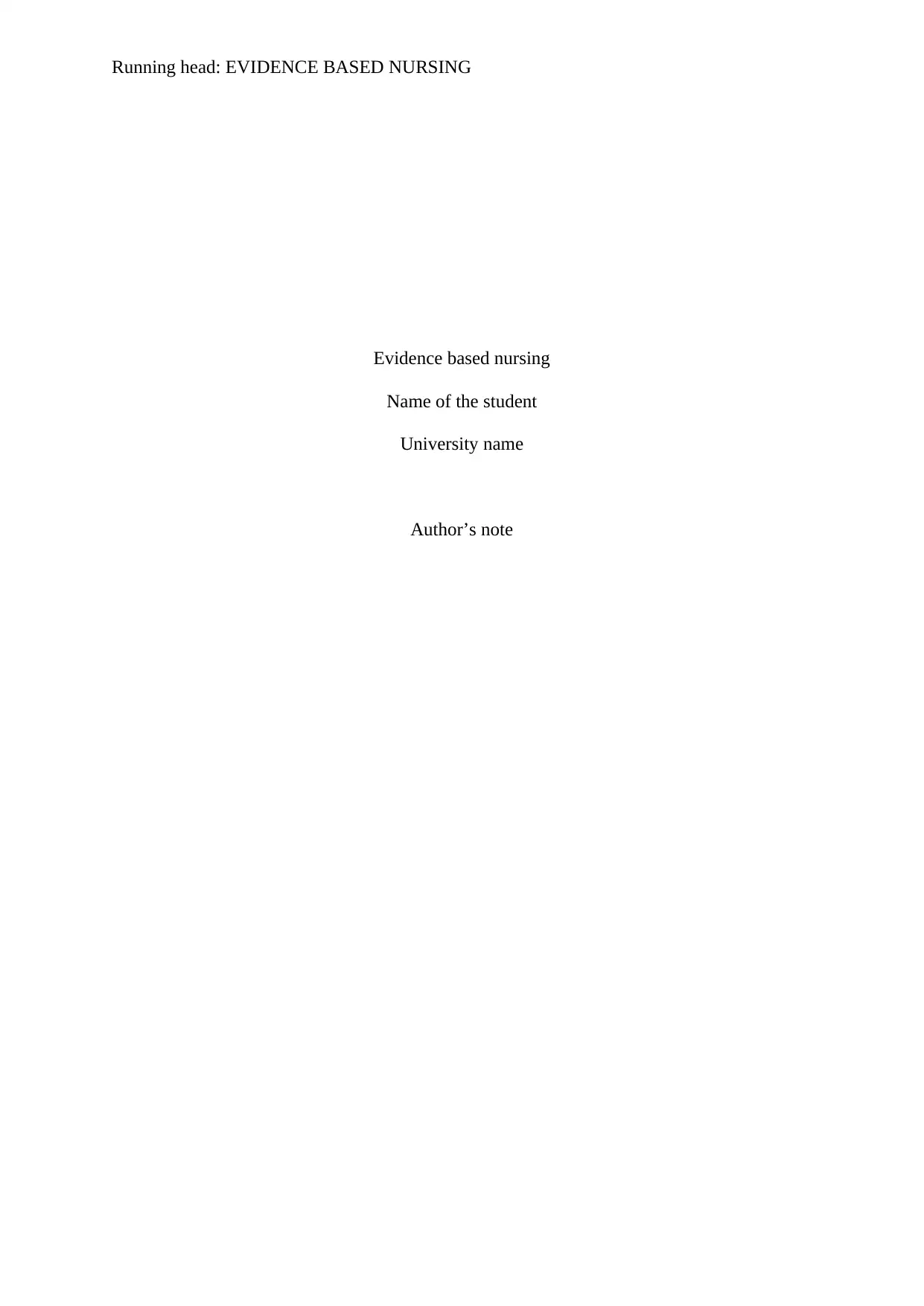
Running head: EVIDENCE BASED NURSING
Evidence based nursing
Name of the student
University name
Author’s note
Evidence based nursing
Name of the student
University name
Author’s note
Paraphrase This Document
Need a fresh take? Get an instant paraphrase of this document with our AI Paraphraser
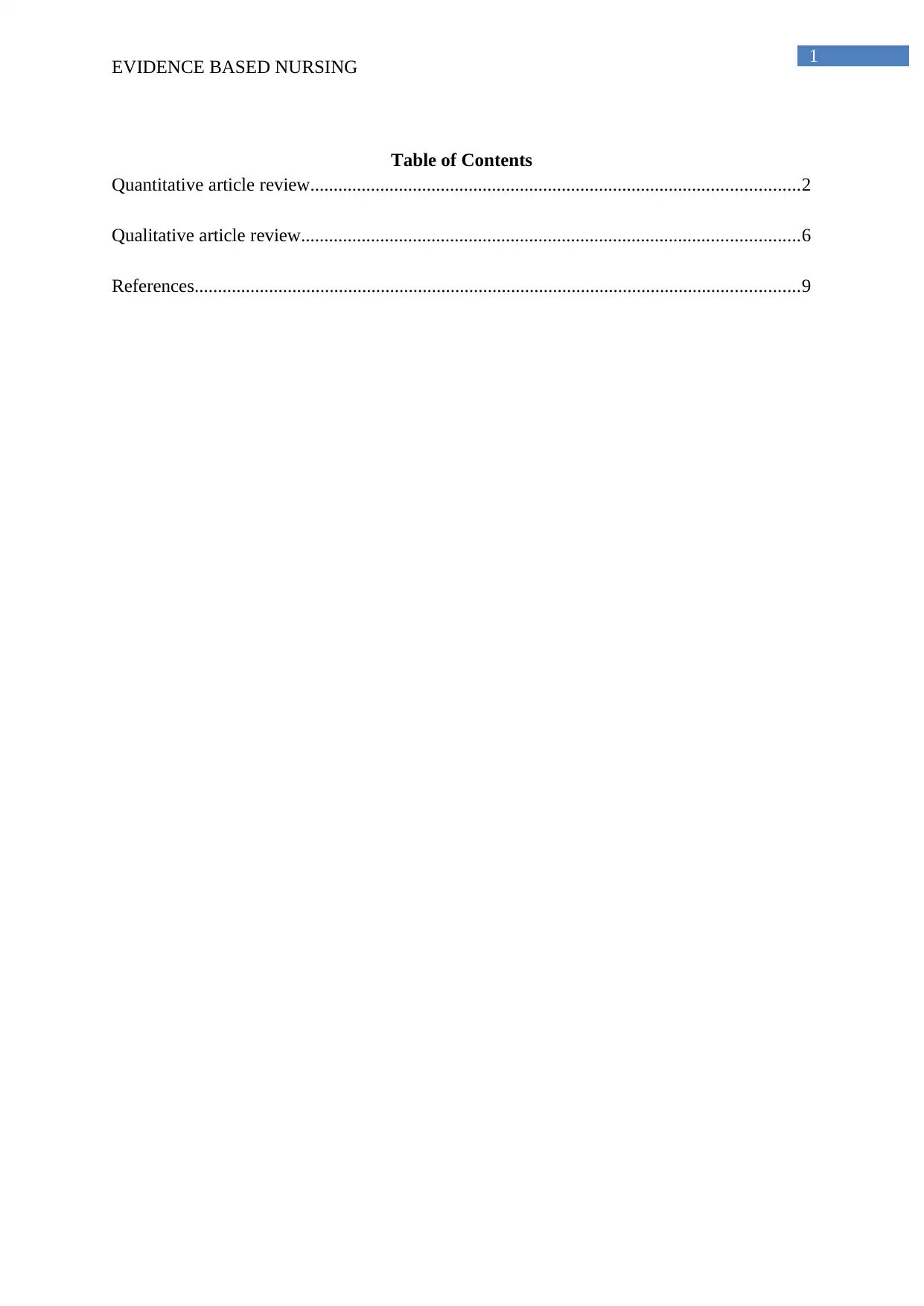
1
EVIDENCE BASED NURSING
Table of Contents
Quantitative article review.........................................................................................................2
Qualitative article review...........................................................................................................6
References..................................................................................................................................9
EVIDENCE BASED NURSING
Table of Contents
Quantitative article review.........................................................................................................2
Qualitative article review...........................................................................................................6
References..................................................................................................................................9
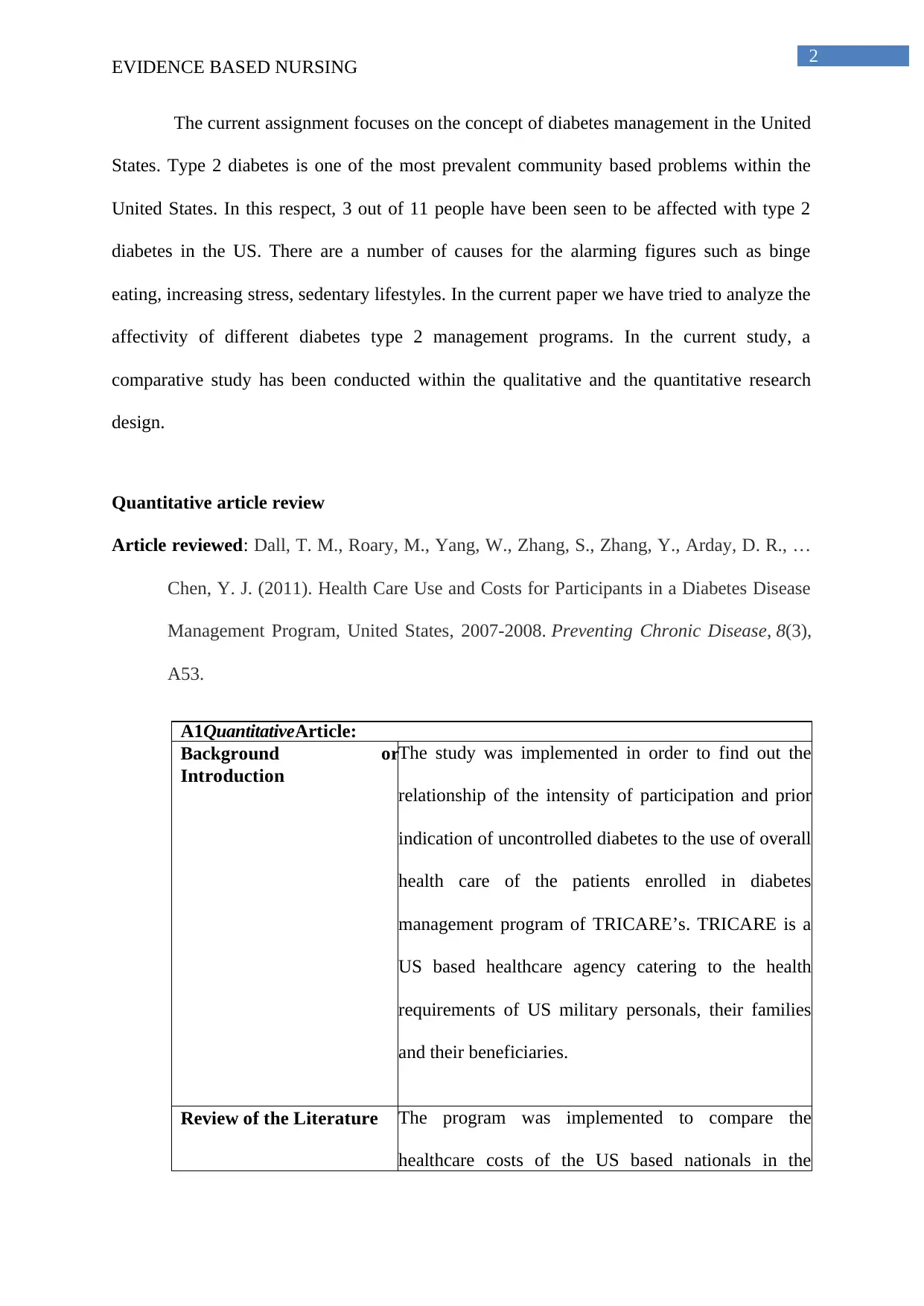
2
EVIDENCE BASED NURSING
The current assignment focuses on the concept of diabetes management in the United
States. Type 2 diabetes is one of the most prevalent community based problems within the
United States. In this respect, 3 out of 11 people have been seen to be affected with type 2
diabetes in the US. There are a number of causes for the alarming figures such as binge
eating, increasing stress, sedentary lifestyles. In the current paper we have tried to analyze the
affectivity of different diabetes type 2 management programs. In the current study, a
comparative study has been conducted within the qualitative and the quantitative research
design.
Quantitative article review
Article reviewed: Dall, T. M., Roary, M., Yang, W., Zhang, S., Zhang, Y., Arday, D. R., …
Chen, Y. J. (2011). Health Care Use and Costs for Participants in a Diabetes Disease
Management Program, United States, 2007-2008. Preventing Chronic Disease, 8(3),
A53.
A1QuantitativeArticle:
Background or
In t ro du ctio n
The study was implemented in order to find out the
relationship of the intensity of participation and prior
indication of uncontrolled diabetes to the use of overall
health care of the patients enrolled in diabetes
management program of TRICARE’s. TRICARE is a
US based healthcare agency catering to the health
requirements of US military personals, their families
and their beneficiaries.
Review of the L it erat ure The program was implemented to compare the
healthcare costs of the US based nationals in the
EVIDENCE BASED NURSING
The current assignment focuses on the concept of diabetes management in the United
States. Type 2 diabetes is one of the most prevalent community based problems within the
United States. In this respect, 3 out of 11 people have been seen to be affected with type 2
diabetes in the US. There are a number of causes for the alarming figures such as binge
eating, increasing stress, sedentary lifestyles. In the current paper we have tried to analyze the
affectivity of different diabetes type 2 management programs. In the current study, a
comparative study has been conducted within the qualitative and the quantitative research
design.
Quantitative article review
Article reviewed: Dall, T. M., Roary, M., Yang, W., Zhang, S., Zhang, Y., Arday, D. R., …
Chen, Y. J. (2011). Health Care Use and Costs for Participants in a Diabetes Disease
Management Program, United States, 2007-2008. Preventing Chronic Disease, 8(3),
A53.
A1QuantitativeArticle:
Background or
In t ro du ctio n
The study was implemented in order to find out the
relationship of the intensity of participation and prior
indication of uncontrolled diabetes to the use of overall
health care of the patients enrolled in diabetes
management program of TRICARE’s. TRICARE is a
US based healthcare agency catering to the health
requirements of US military personals, their families
and their beneficiaries.
Review of the L it erat ure The program was implemented to compare the
healthcare costs of the US based nationals in the
⊘ This is a preview!⊘
Do you want full access?
Subscribe today to unlock all pages.

Trusted by 1+ million students worldwide
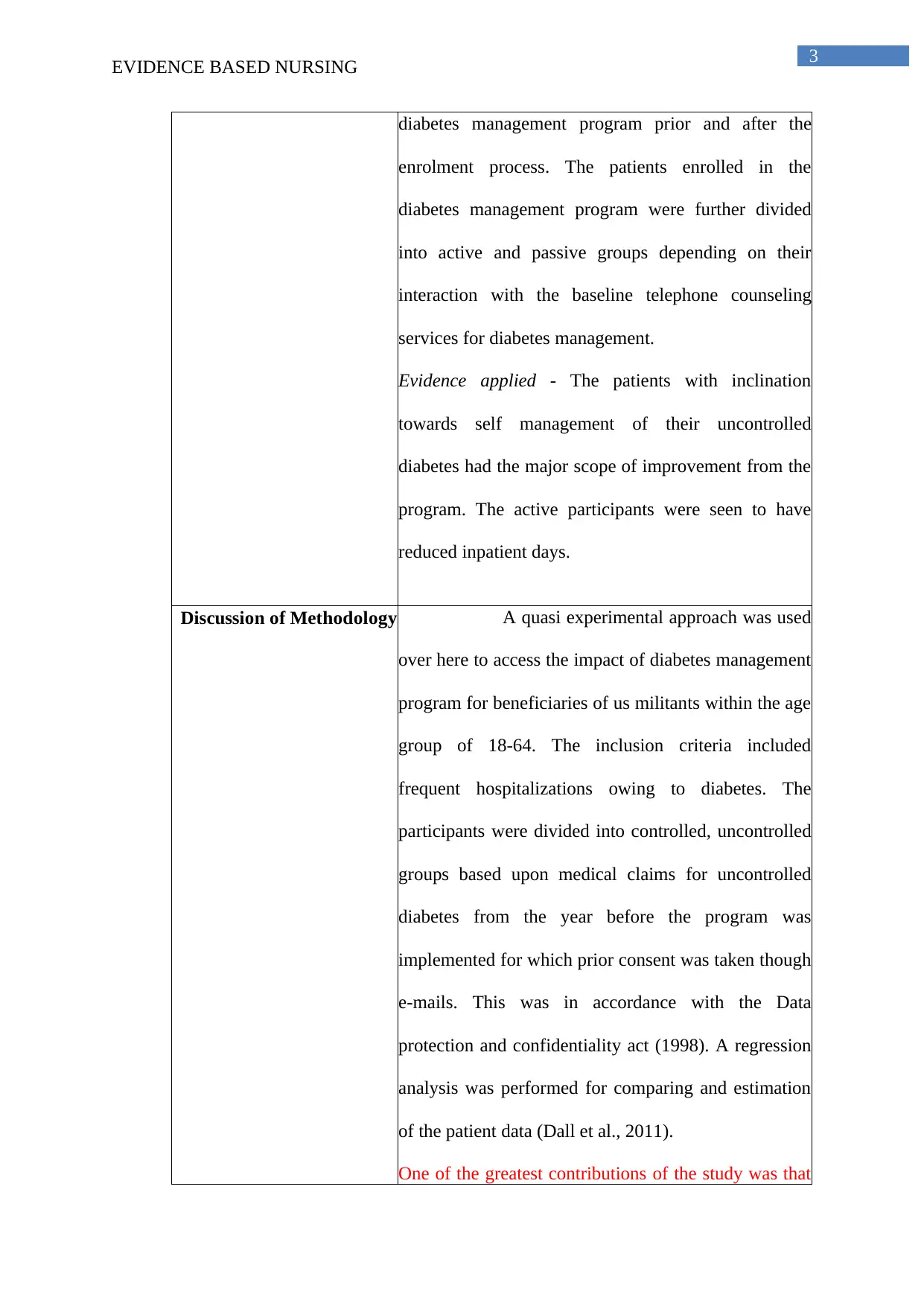
3
EVIDENCE BASED NURSING
diabetes management program prior and after the
enrolment process. The patients enrolled in the
diabetes management program were further divided
into active and passive groups depending on their
interaction with the baseline telephone counseling
services for diabetes management.
Evidence applied - The patients with inclination
towards self management of their uncontrolled
diabetes had the major scope of improvement from the
program. The active participants were seen to have
reduced inpatient days.
Discussion of Met h o d olo g y A quasi experimental approach was used
over here to access the impact of diabetes management
program for beneficiaries of us militants within the age
group of 18-64. The inclusion criteria included
frequent hospitalizations owing to diabetes. The
participants were divided into controlled, uncontrolled
groups based upon medical claims for uncontrolled
diabetes from the year before the program was
implemented for which prior consent was taken though
e-mails. This was in accordance with the Data
protection and confidentiality act (1998). A regression
analysis was performed for comparing and estimation
of the patient data (Dall et al., 2011).
One of the greatest contributions of the study was that
EVIDENCE BASED NURSING
diabetes management program prior and after the
enrolment process. The patients enrolled in the
diabetes management program were further divided
into active and passive groups depending on their
interaction with the baseline telephone counseling
services for diabetes management.
Evidence applied - The patients with inclination
towards self management of their uncontrolled
diabetes had the major scope of improvement from the
program. The active participants were seen to have
reduced inpatient days.
Discussion of Met h o d olo g y A quasi experimental approach was used
over here to access the impact of diabetes management
program for beneficiaries of us militants within the age
group of 18-64. The inclusion criteria included
frequent hospitalizations owing to diabetes. The
participants were divided into controlled, uncontrolled
groups based upon medical claims for uncontrolled
diabetes from the year before the program was
implemented for which prior consent was taken though
e-mails. This was in accordance with the Data
protection and confidentiality act (1998). A regression
analysis was performed for comparing and estimation
of the patient data (Dall et al., 2011).
One of the greatest contributions of the study was that
Paraphrase This Document
Need a fresh take? Get an instant paraphrase of this document with our AI Paraphraser
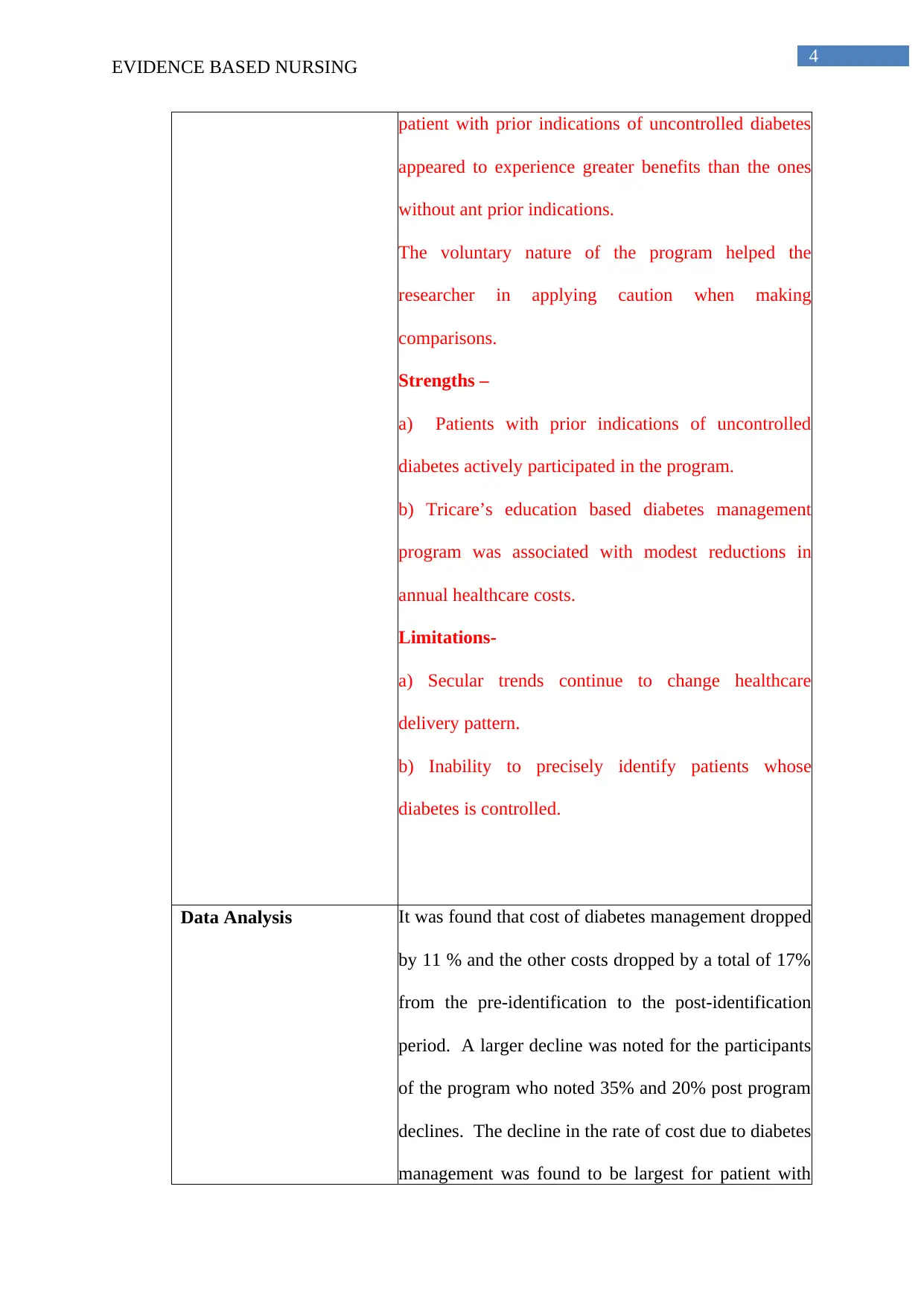
4
EVIDENCE BASED NURSING
patient with prior indications of uncontrolled diabetes
appeared to experience greater benefits than the ones
without ant prior indications.
The voluntary nature of the program helped the
researcher in applying caution when making
comparisons.
Strengths –
a) Patients with prior indications of uncontrolled
diabetes actively participated in the program.
b) Tricare’s education based diabetes management
program was associated with modest reductions in
annual healthcare costs.
Limitations-
a) Secular trends continue to change healthcare
delivery pattern.
b) Inability to precisely identify patients whose
diabetes is controlled.
Data An aly si s It was found that cost of diabetes management dropped
by 11 % and the other costs dropped by a total of 17%
from the pre-identification to the post-identification
period. A larger decline was noted for the participants
of the program who noted 35% and 20% post program
declines. The decline in the rate of cost due to diabetes
management was found to be largest for patient with
EVIDENCE BASED NURSING
patient with prior indications of uncontrolled diabetes
appeared to experience greater benefits than the ones
without ant prior indications.
The voluntary nature of the program helped the
researcher in applying caution when making
comparisons.
Strengths –
a) Patients with prior indications of uncontrolled
diabetes actively participated in the program.
b) Tricare’s education based diabetes management
program was associated with modest reductions in
annual healthcare costs.
Limitations-
a) Secular trends continue to change healthcare
delivery pattern.
b) Inability to precisely identify patients whose
diabetes is controlled.
Data An aly si s It was found that cost of diabetes management dropped
by 11 % and the other costs dropped by a total of 17%
from the pre-identification to the post-identification
period. A larger decline was noted for the participants
of the program who noted 35% and 20% post program
declines. The decline in the rate of cost due to diabetes
management was found to be largest for patient with
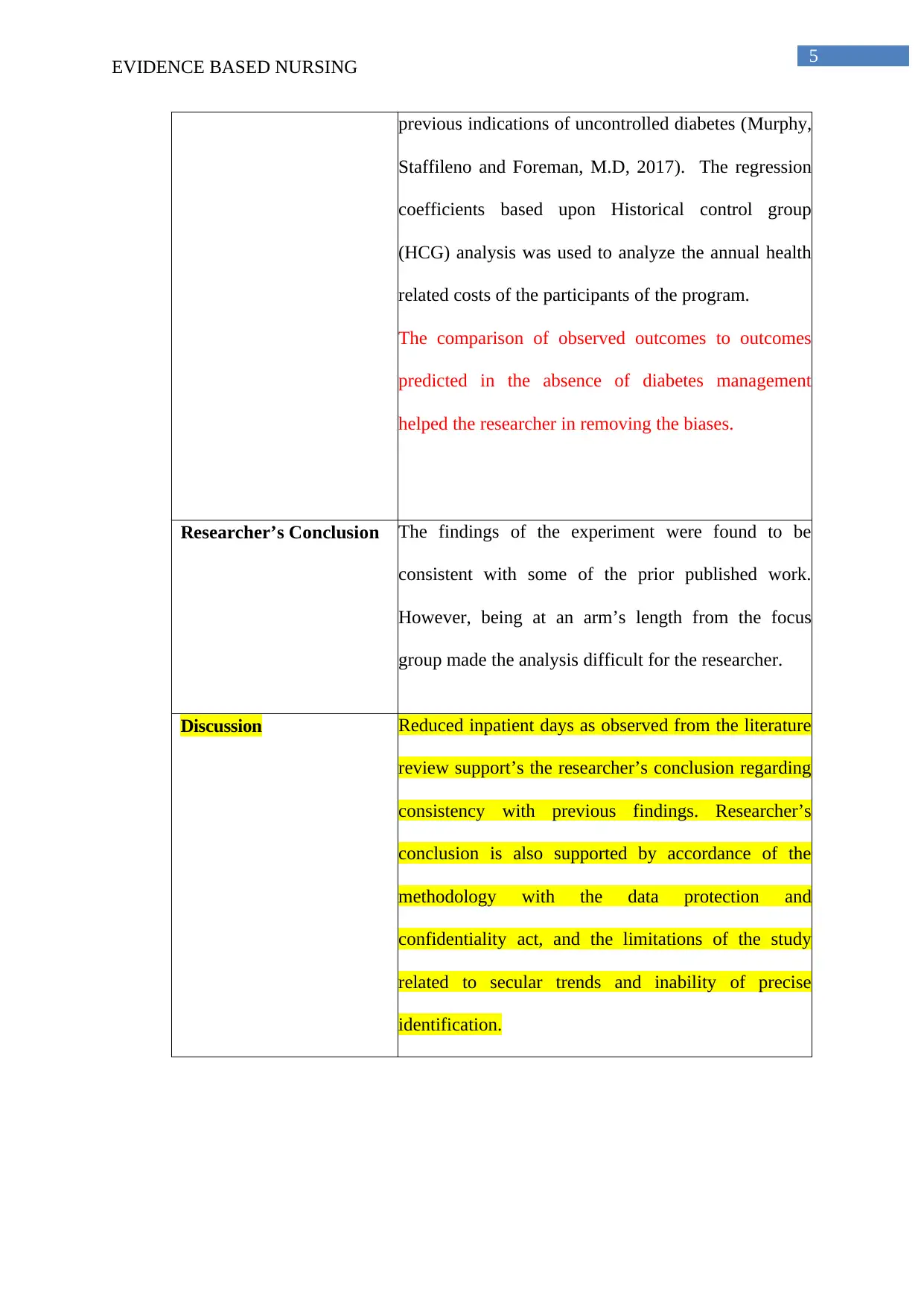
5
EVIDENCE BASED NURSING
previous indications of uncontrolled diabetes (Murphy,
Staffileno and Foreman, M.D, 2017). The regression
coefficients based upon Historical control group
(HCG) analysis was used to analyze the annual health
related costs of the participants of the program.
The comparison of observed outcomes to outcomes
predicted in the absence of diabetes management
helped the researcher in removing the biases.
Researcher’s Conclusion The findings of the experiment were found to be
consistent with some of the prior published work.
However, being at an arm’s length from the focus
group made the analysis difficult for the researcher.
Discussion Reduced inpatient days as observed from the literature
review support’s the researcher’s conclusion regarding
consistency with previous findings. Researcher’s
conclusion is also supported by accordance of the
methodology with the data protection and
confidentiality act, and the limitations of the study
related to secular trends and inability of precise
identification.
EVIDENCE BASED NURSING
previous indications of uncontrolled diabetes (Murphy,
Staffileno and Foreman, M.D, 2017). The regression
coefficients based upon Historical control group
(HCG) analysis was used to analyze the annual health
related costs of the participants of the program.
The comparison of observed outcomes to outcomes
predicted in the absence of diabetes management
helped the researcher in removing the biases.
Researcher’s Conclusion The findings of the experiment were found to be
consistent with some of the prior published work.
However, being at an arm’s length from the focus
group made the analysis difficult for the researcher.
Discussion Reduced inpatient days as observed from the literature
review support’s the researcher’s conclusion regarding
consistency with previous findings. Researcher’s
conclusion is also supported by accordance of the
methodology with the data protection and
confidentiality act, and the limitations of the study
related to secular trends and inability of precise
identification.
⊘ This is a preview!⊘
Do you want full access?
Subscribe today to unlock all pages.

Trusted by 1+ million students worldwide
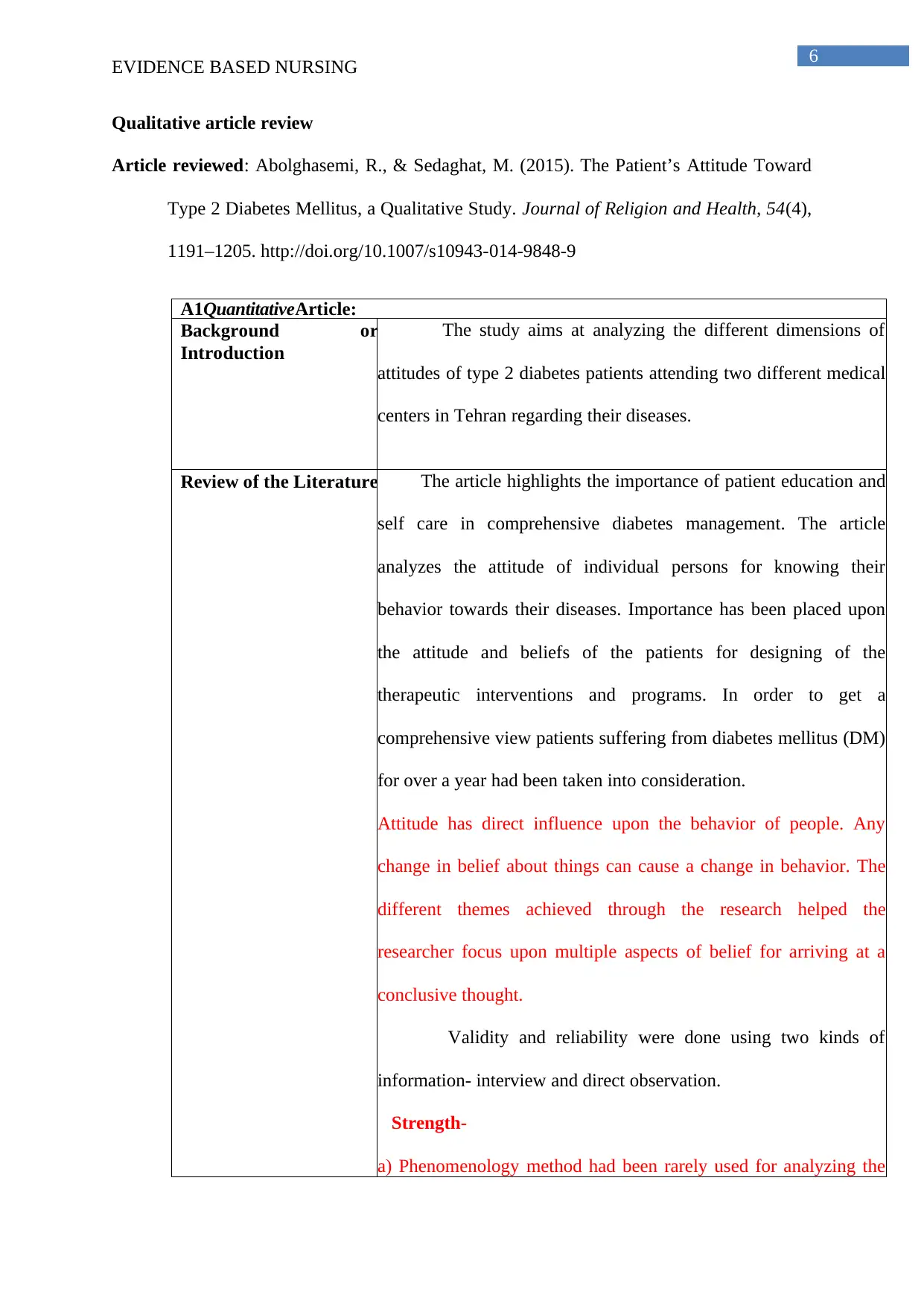
6
EVIDENCE BASED NURSING
Qualitative article review
Article reviewed: Abolghasemi, R., & Sedaghat, M. (2015). The Patient’s Attitude Toward
Type 2 Diabetes Mellitus, a Qualitative Study. Journal of Religion and Health, 54(4),
1191–1205. http://doi.org/10.1007/s10943-014-9848-9
A1QuantitativeArticle:
Background or
In t ro du ctio n
The study aims at analyzing the different dimensions of
attitudes of type 2 diabetes patients attending two different medical
centers in Tehran regarding their diseases.
Review of the L it erat ure The article highlights the importance of patient education and
self care in comprehensive diabetes management. The article
analyzes the attitude of individual persons for knowing their
behavior towards their diseases. Importance has been placed upon
the attitude and beliefs of the patients for designing of the
therapeutic interventions and programs. In order to get a
comprehensive view patients suffering from diabetes mellitus (DM)
for over a year had been taken into consideration.
Attitude has direct influence upon the behavior of people. Any
change in belief about things can cause a change in behavior. The
different themes achieved through the research helped the
researcher focus upon multiple aspects of belief for arriving at a
conclusive thought.
Validity and reliability were done using two kinds of
information- interview and direct observation.
Strength-
a) Phenomenology method had been rarely used for analyzing the
EVIDENCE BASED NURSING
Qualitative article review
Article reviewed: Abolghasemi, R., & Sedaghat, M. (2015). The Patient’s Attitude Toward
Type 2 Diabetes Mellitus, a Qualitative Study. Journal of Religion and Health, 54(4),
1191–1205. http://doi.org/10.1007/s10943-014-9848-9
A1QuantitativeArticle:
Background or
In t ro du ctio n
The study aims at analyzing the different dimensions of
attitudes of type 2 diabetes patients attending two different medical
centers in Tehran regarding their diseases.
Review of the L it erat ure The article highlights the importance of patient education and
self care in comprehensive diabetes management. The article
analyzes the attitude of individual persons for knowing their
behavior towards their diseases. Importance has been placed upon
the attitude and beliefs of the patients for designing of the
therapeutic interventions and programs. In order to get a
comprehensive view patients suffering from diabetes mellitus (DM)
for over a year had been taken into consideration.
Attitude has direct influence upon the behavior of people. Any
change in belief about things can cause a change in behavior. The
different themes achieved through the research helped the
researcher focus upon multiple aspects of belief for arriving at a
conclusive thought.
Validity and reliability were done using two kinds of
information- interview and direct observation.
Strength-
a) Phenomenology method had been rarely used for analyzing the
Paraphrase This Document
Need a fresh take? Get an instant paraphrase of this document with our AI Paraphraser
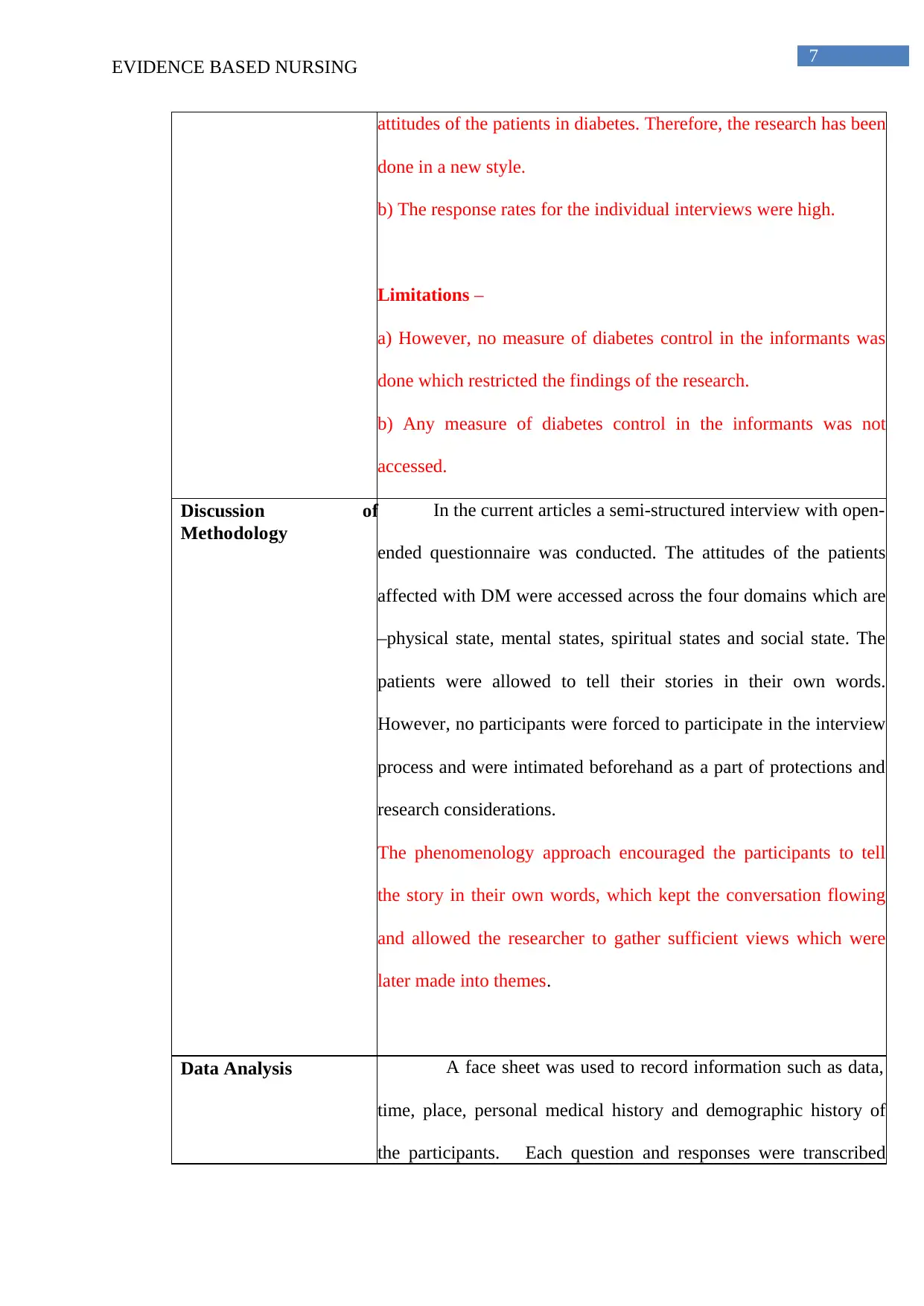
7
EVIDENCE BASED NURSING
attitudes of the patients in diabetes. Therefore, the research has been
done in a new style.
b) The response rates for the individual interviews were high.
Limitations –
a) However, no measure of diabetes control in the informants was
done which restricted the findings of the research.
b) Any measure of diabetes control in the informants was not
accessed.
Discussion of
Met h o d olo g y
In the current articles a semi-structured interview with open-
ended questionnaire was conducted. The attitudes of the patients
affected with DM were accessed across the four domains which are
–physical state, mental states, spiritual states and social state. The
patients were allowed to tell their stories in their own words.
However, no participants were forced to participate in the interview
process and were intimated beforehand as a part of protections and
research considerations.
The phenomenology approach encouraged the participants to tell
the story in their own words, which kept the conversation flowing
and allowed the researcher to gather sufficient views which were
later made into themes.
Data An aly si s A face sheet was used to record information such as data,
time, place, personal medical history and demographic history of
the participants. Each question and responses were transcribed
EVIDENCE BASED NURSING
attitudes of the patients in diabetes. Therefore, the research has been
done in a new style.
b) The response rates for the individual interviews were high.
Limitations –
a) However, no measure of diabetes control in the informants was
done which restricted the findings of the research.
b) Any measure of diabetes control in the informants was not
accessed.
Discussion of
Met h o d olo g y
In the current articles a semi-structured interview with open-
ended questionnaire was conducted. The attitudes of the patients
affected with DM were accessed across the four domains which are
–physical state, mental states, spiritual states and social state. The
patients were allowed to tell their stories in their own words.
However, no participants were forced to participate in the interview
process and were intimated beforehand as a part of protections and
research considerations.
The phenomenology approach encouraged the participants to tell
the story in their own words, which kept the conversation flowing
and allowed the researcher to gather sufficient views which were
later made into themes.
Data An aly si s A face sheet was used to record information such as data,
time, place, personal medical history and demographic history of
the participants. Each question and responses were transcribed
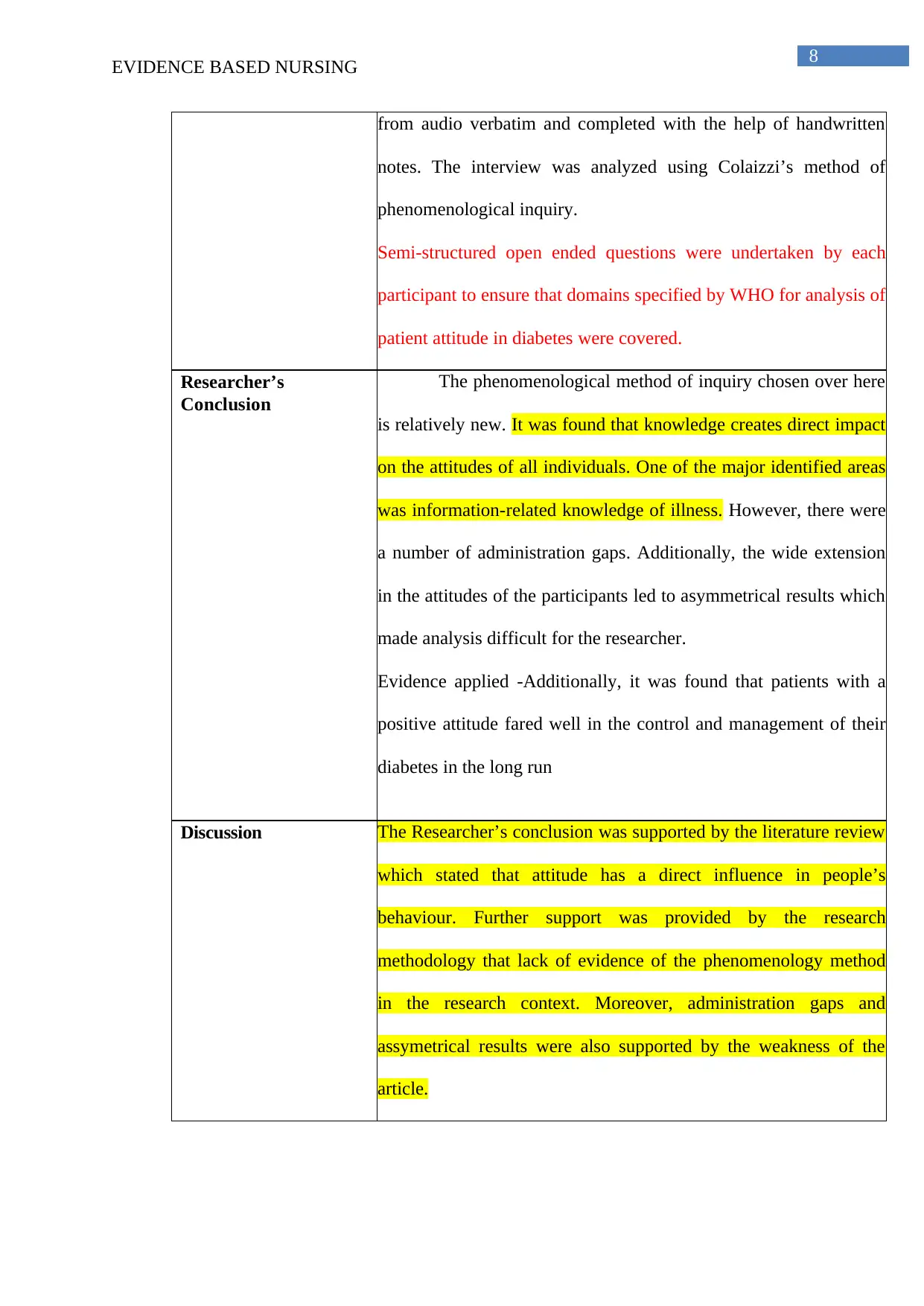
8
EVIDENCE BASED NURSING
from audio verbatim and completed with the help of handwritten
notes. The interview was analyzed using Colaizzi’s method of
phenomenological inquiry.
Semi-structured open ended questions were undertaken by each
participant to ensure that domains specified by WHO for analysis of
patient attitude in diabetes were covered.
Researcher’s
Conclusion
The phenomenological method of inquiry chosen over here
is relatively new. It was found that knowledge creates direct impact
on the attitudes of all individuals. One of the major identified areas
was information-related knowledge of illness. However, there were
a number of administration gaps. Additionally, the wide extension
in the attitudes of the participants led to asymmetrical results which
made analysis difficult for the researcher.
Evidence applied -Additionally, it was found that patients with a
positive attitude fared well in the control and management of their
diabetes in the long run
Discussion The Researcher’s conclusion was supported by the literature review
which stated that attitude has a direct influence in people’s
behaviour. Further support was provided by the research
methodology that lack of evidence of the phenomenology method
in the research context. Moreover, administration gaps and
assymetrical results were also supported by the weakness of the
article.
EVIDENCE BASED NURSING
from audio verbatim and completed with the help of handwritten
notes. The interview was analyzed using Colaizzi’s method of
phenomenological inquiry.
Semi-structured open ended questions were undertaken by each
participant to ensure that domains specified by WHO for analysis of
patient attitude in diabetes were covered.
Researcher’s
Conclusion
The phenomenological method of inquiry chosen over here
is relatively new. It was found that knowledge creates direct impact
on the attitudes of all individuals. One of the major identified areas
was information-related knowledge of illness. However, there were
a number of administration gaps. Additionally, the wide extension
in the attitudes of the participants led to asymmetrical results which
made analysis difficult for the researcher.
Evidence applied -Additionally, it was found that patients with a
positive attitude fared well in the control and management of their
diabetes in the long run
Discussion The Researcher’s conclusion was supported by the literature review
which stated that attitude has a direct influence in people’s
behaviour. Further support was provided by the research
methodology that lack of evidence of the phenomenology method
in the research context. Moreover, administration gaps and
assymetrical results were also supported by the weakness of the
article.
⊘ This is a preview!⊘
Do you want full access?
Subscribe today to unlock all pages.

Trusted by 1+ million students worldwide
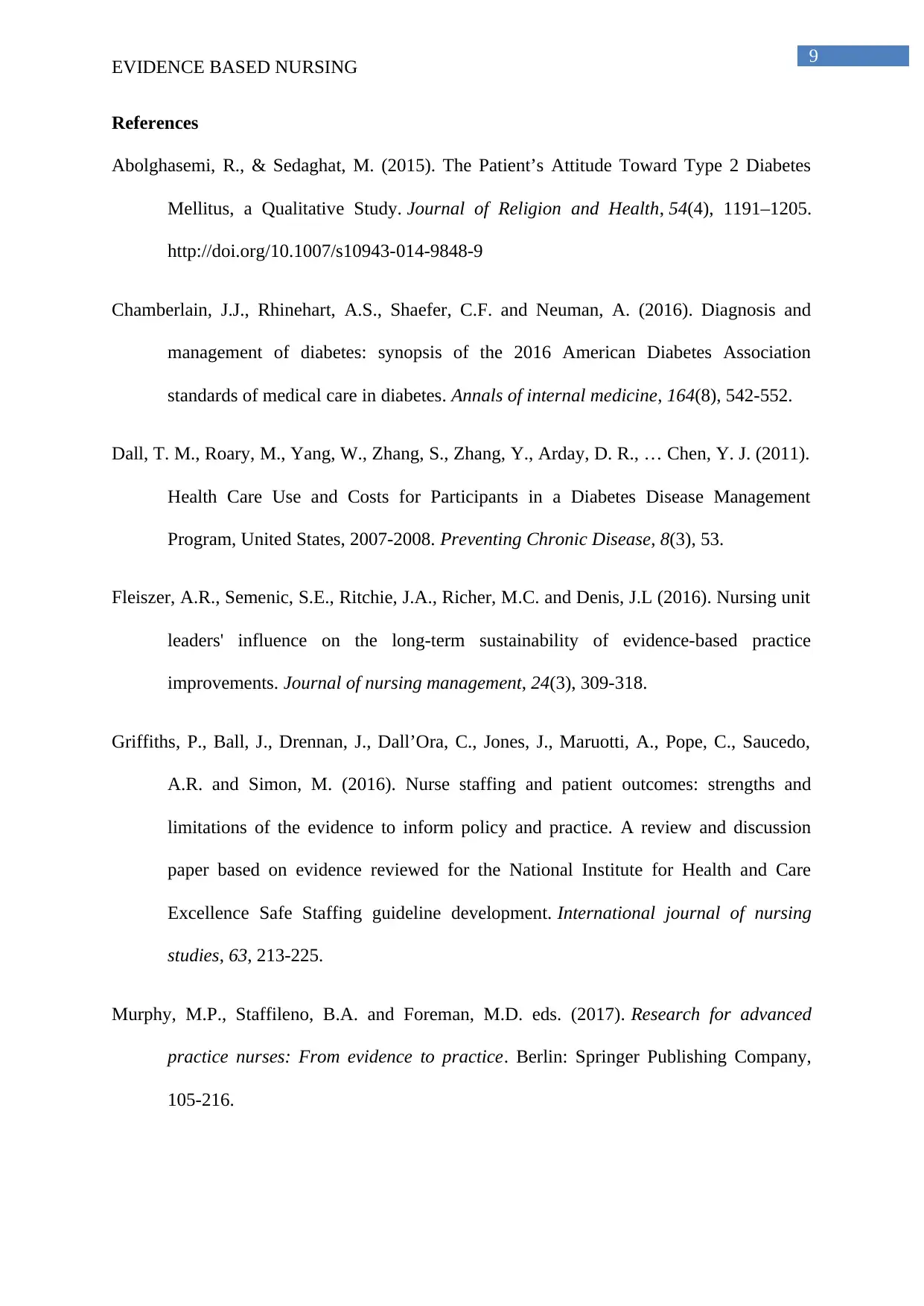
9
EVIDENCE BASED NURSING
References
Abolghasemi, R., & Sedaghat, M. (2015). The Patient’s Attitude Toward Type 2 Diabetes
Mellitus, a Qualitative Study. Journal of Religion and Health, 54(4), 1191–1205.
http://doi.org/10.1007/s10943-014-9848-9
Chamberlain, J.J., Rhinehart, A.S., Shaefer, C.F. and Neuman, A. (2016). Diagnosis and
management of diabetes: synopsis of the 2016 American Diabetes Association
standards of medical care in diabetes. Annals of internal medicine, 164(8), 542-552.
Dall, T. M., Roary, M., Yang, W., Zhang, S., Zhang, Y., Arday, D. R., … Chen, Y. J. (2011).
Health Care Use and Costs for Participants in a Diabetes Disease Management
Program, United States, 2007-2008. Preventing Chronic Disease, 8(3), 53.
Fleiszer, A.R., Semenic, S.E., Ritchie, J.A., Richer, M.C. and Denis, J.L (2016). Nursing unit
leaders' influence on the long‐term sustainability of evidence‐based practice
improvements. Journal of nursing management, 24(3), 309-318.
Griffiths, P., Ball, J., Drennan, J., Dall’Ora, C., Jones, J., Maruotti, A., Pope, C., Saucedo,
A.R. and Simon, M. (2016). Nurse staffing and patient outcomes: strengths and
limitations of the evidence to inform policy and practice. A review and discussion
paper based on evidence reviewed for the National Institute for Health and Care
Excellence Safe Staffing guideline development. International journal of nursing
studies, 63, 213-225.
Murphy, M.P., Staffileno, B.A. and Foreman, M.D. eds. (2017). Research for advanced
practice nurses: From evidence to practice. Berlin: Springer Publishing Company,
105-216.
EVIDENCE BASED NURSING
References
Abolghasemi, R., & Sedaghat, M. (2015). The Patient’s Attitude Toward Type 2 Diabetes
Mellitus, a Qualitative Study. Journal of Religion and Health, 54(4), 1191–1205.
http://doi.org/10.1007/s10943-014-9848-9
Chamberlain, J.J., Rhinehart, A.S., Shaefer, C.F. and Neuman, A. (2016). Diagnosis and
management of diabetes: synopsis of the 2016 American Diabetes Association
standards of medical care in diabetes. Annals of internal medicine, 164(8), 542-552.
Dall, T. M., Roary, M., Yang, W., Zhang, S., Zhang, Y., Arday, D. R., … Chen, Y. J. (2011).
Health Care Use and Costs for Participants in a Diabetes Disease Management
Program, United States, 2007-2008. Preventing Chronic Disease, 8(3), 53.
Fleiszer, A.R., Semenic, S.E., Ritchie, J.A., Richer, M.C. and Denis, J.L (2016). Nursing unit
leaders' influence on the long‐term sustainability of evidence‐based practice
improvements. Journal of nursing management, 24(3), 309-318.
Griffiths, P., Ball, J., Drennan, J., Dall’Ora, C., Jones, J., Maruotti, A., Pope, C., Saucedo,
A.R. and Simon, M. (2016). Nurse staffing and patient outcomes: strengths and
limitations of the evidence to inform policy and practice. A review and discussion
paper based on evidence reviewed for the National Institute for Health and Care
Excellence Safe Staffing guideline development. International journal of nursing
studies, 63, 213-225.
Murphy, M.P., Staffileno, B.A. and Foreman, M.D. eds. (2017). Research for advanced
practice nurses: From evidence to practice. Berlin: Springer Publishing Company,
105-216.
Paraphrase This Document
Need a fresh take? Get an instant paraphrase of this document with our AI Paraphraser
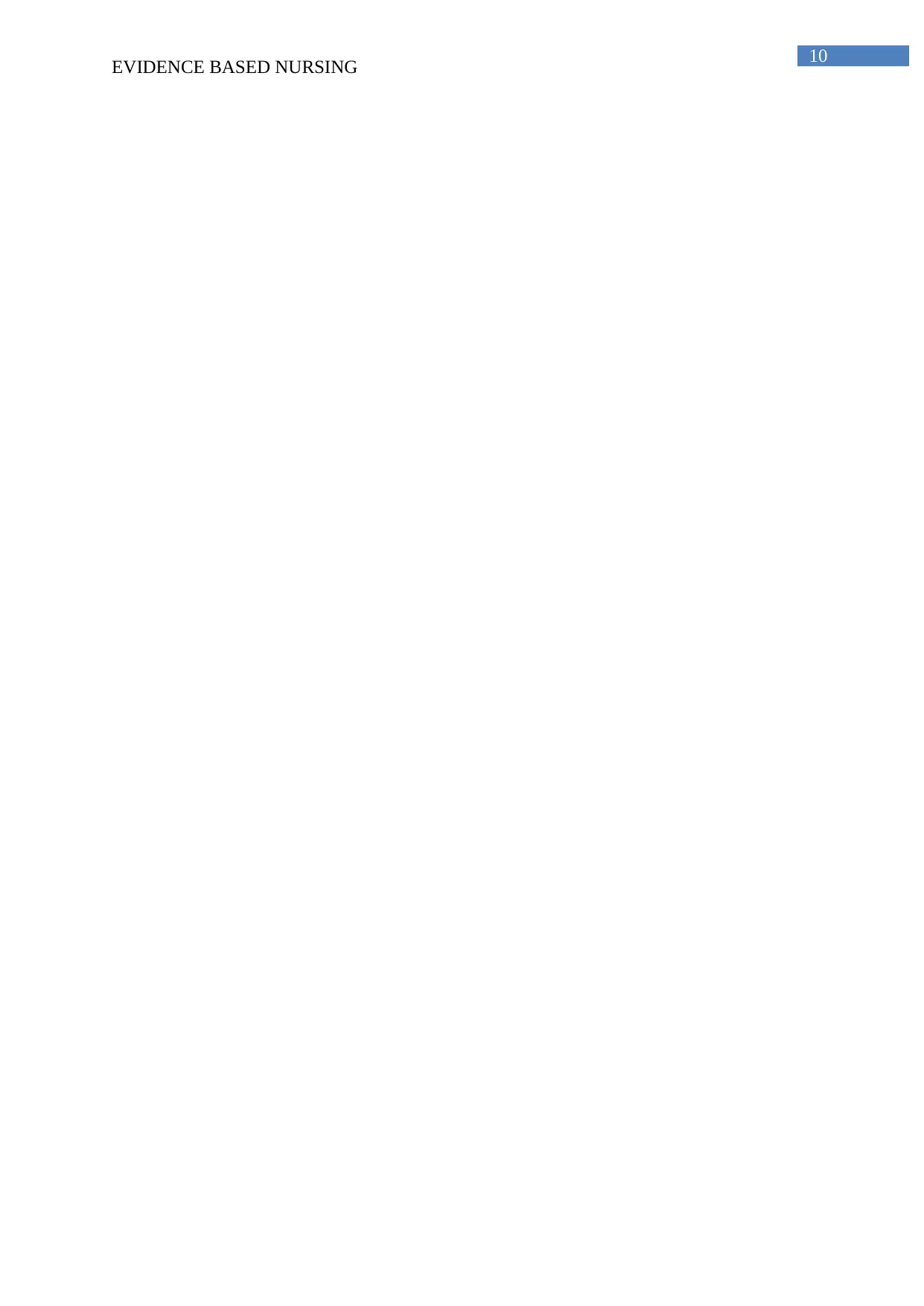
10
EVIDENCE BASED NURSING
EVIDENCE BASED NURSING
1 out of 11
Related Documents
Your All-in-One AI-Powered Toolkit for Academic Success.
+13062052269
info@desklib.com
Available 24*7 on WhatsApp / Email
![[object Object]](/_next/static/media/star-bottom.7253800d.svg)
Unlock your academic potential
Copyright © 2020–2025 A2Z Services. All Rights Reserved. Developed and managed by ZUCOL.





